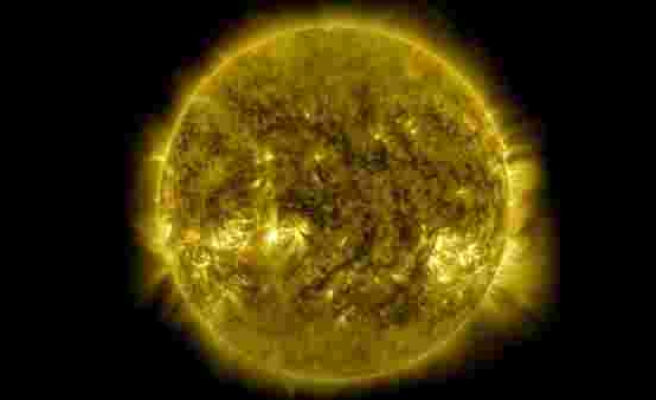Şubat 2010'dan bu yandan, NASA'nın Solar Dynamics Observatory (Güneş Dinamikleri Gözlemevi – SDO) Güneş'in yaklaşık 425 milyon adet yüksek çözünürlüklü fotoğrafını çekerek astronomların Güneş'teki hemencecik her olayı ayrıntılı bir şekilde incelemelerine olanak tanıdı. SDO'nun hizmet verdiği ilk on yılı kutlamak için de ajans, geçtiğimiz 10 sene boyunca her gün için saniyede bir adet fotoğrafın gösterildiği güzel bir hızlandırılmış video yayınladı.
4K olarak da izlenebilen bu güzel video, fazla ultraviyole dalga boyu olan ve yıldızın "corona" olarak tanıdık en dış atmosferini belirten 17,1 nanometrede çekildi.
 A Decade of SunAs of June 2020, NASA’s Solar Dynamics Observatory — SDO — has now been watching the Sun non-stop for over a full decade. From its orbit in space around the Earth, SDO has gathered 425 million high-resolution images of the Sun, amassing 20 million gigabytes of data over the past 10 years. This information has enabled countless new discoveries about the workings of our closest star and how it influences the solar system. With a triad of instruments, SDO captures an image of the Sun every 0.75 seconds. The Atmospheric Imaging Assembly (AIA) instrument alone captures images every 12 seconds at 10 different wavelengths of light. This 10-year time lapse showcases photos taken at a wavelength of 17.1 nanometers, which is lahza extreme ultraviolet wavelength that shows the Sun’s outermost atmospheric layer — the corona. Compiling one photo every hour, the movie condenses a decade of the Sun into 61 minutes. The video shows the rise and fall in activity that occurs as part of the Sun’s 11-year solar cycle and notable events, like transiting planets and eruptions. The custom music, titled “Solar Observer,” was composed by musician Lars Leonhard ). While SDO has kept an unblinking eye pointed towards the Sun, there have been a few moments it missed. The dark frames in the video are caused by Earth or the Moon eclipsing SDO as they pass between the spacecraft and the Sun. A longer blackout in 2016 was caused by a temporary issue with the AIA instrument that was successfully resolved after a week. The images where the Sun is off-center were observed when SDO was calibrating its instruments. SDO and other NASA missions will continue to watch our Sun in the years to come, providing further insights about our place in space and information to keep our astronauts and assets safe. Some noteworthy events appear briefly in this time lapse. Use the time links below to jump to each event, or follow the links to more detailed views. 6:20 June 7, 2011-- A massive prominence eruption explodes from the lower right of the Sun. See the video: 12:24 June 5, 2012-- The transit of Venus across the face of the Sun. Won’t happen again until 2117. See the video: 13:06 July 19, 2012-- A complex loop of magnetic fields and plasma forms and lasts for hours. See the video: 13:50 Aug. 31, 2012-- The most iconic eruption of this solar cycle bursts from the lower left of the Sun. See the video: 20:25 Sept. 29, 2013-- A prominence eruption forms a long 'canyon’ that is then covered with loops of plasma. See the video: 26:39 Oct. 8, 2014-- Active regions on the Sun resemble a jack o’ lantern just in time for Halloween. 36:18 May 9, 2016-- Mercury transits across the face of the Sun. Smaller and more distant than Venus it is hard to spot. See the video: 43:20 July 5, 2017-- A large sunspot group spends two weeks crossing the face of the Sun. See the video: 44:20 Sept. 6, 2017-- The most powerful sequence of flares during this solar cycle crackle for several days, peaking at X9.3. See the video: 57:38 Nov. 11, 2019-- Mercury transits the Sun once more for SDO. The next transit won’t be until 2032. See the video: Read more: Music: "Solar Observer" written and produced for this video by Lars Leonhard ) Video credit: NASA's Goddard Space Flight Center/SDO Scott Wiessinger (USRA): Lead Producer Tom Bridgman (GST): Lead Data Visualizer Mara Johnson-Groh (Wyle Information Systems): Lead Science Writer This video is public domain and along with other supporting visualizations can be downloaded from NASA Goddard's Scientific Visualization Studio at: If you liked this video, subscribe to the NASA Goddard YouTube channel: Follow NASA’s Goddard Space Flight Center · Instagram · Twitter · Twitter · Facebook: · Flickr
A Decade of SunAs of June 2020, NASA’s Solar Dynamics Observatory — SDO — has now been watching the Sun non-stop for over a full decade. From its orbit in space around the Earth, SDO has gathered 425 million high-resolution images of the Sun, amassing 20 million gigabytes of data over the past 10 years. This information has enabled countless new discoveries about the workings of our closest star and how it influences the solar system. With a triad of instruments, SDO captures an image of the Sun every 0.75 seconds. The Atmospheric Imaging Assembly (AIA) instrument alone captures images every 12 seconds at 10 different wavelengths of light. This 10-year time lapse showcases photos taken at a wavelength of 17.1 nanometers, which is lahza extreme ultraviolet wavelength that shows the Sun’s outermost atmospheric layer — the corona. Compiling one photo every hour, the movie condenses a decade of the Sun into 61 minutes. The video shows the rise and fall in activity that occurs as part of the Sun’s 11-year solar cycle and notable events, like transiting planets and eruptions. The custom music, titled “Solar Observer,” was composed by musician Lars Leonhard ). While SDO has kept an unblinking eye pointed towards the Sun, there have been a few moments it missed. The dark frames in the video are caused by Earth or the Moon eclipsing SDO as they pass between the spacecraft and the Sun. A longer blackout in 2016 was caused by a temporary issue with the AIA instrument that was successfully resolved after a week. The images where the Sun is off-center were observed when SDO was calibrating its instruments. SDO and other NASA missions will continue to watch our Sun in the years to come, providing further insights about our place in space and information to keep our astronauts and assets safe. Some noteworthy events appear briefly in this time lapse. Use the time links below to jump to each event, or follow the links to more detailed views. 6:20 June 7, 2011-- A massive prominence eruption explodes from the lower right of the Sun. See the video: 12:24 June 5, 2012-- The transit of Venus across the face of the Sun. Won’t happen again until 2117. See the video: 13:06 July 19, 2012-- A complex loop of magnetic fields and plasma forms and lasts for hours. See the video: 13:50 Aug. 31, 2012-- The most iconic eruption of this solar cycle bursts from the lower left of the Sun. See the video: 20:25 Sept. 29, 2013-- A prominence eruption forms a long 'canyon’ that is then covered with loops of plasma. See the video: 26:39 Oct. 8, 2014-- Active regions on the Sun resemble a jack o’ lantern just in time for Halloween. 36:18 May 9, 2016-- Mercury transits across the face of the Sun. Smaller and more distant than Venus it is hard to spot. See the video: 43:20 July 5, 2017-- A large sunspot group spends two weeks crossing the face of the Sun. See the video: 44:20 Sept. 6, 2017-- The most powerful sequence of flares during this solar cycle crackle for several days, peaking at X9.3. See the video: 57:38 Nov. 11, 2019-- Mercury transits the Sun once more for SDO. The next transit won’t be until 2032. See the video: Read more: Music: "Solar Observer" written and produced for this video by Lars Leonhard ) Video credit: NASA's Goddard Space Flight Center/SDO Scott Wiessinger (USRA): Lead Producer Tom Bridgman (GST): Lead Data Visualizer Mara Johnson-Groh (Wyle Information Systems): Lead Science Writer This video is public domain and along with other supporting visualizations can be downloaded from NASA Goddard's Scientific Visualization Studio at: If you liked this video, subscribe to the NASA Goddard YouTube channel: Follow NASA’s Goddard Space Flight Center · Instagram · Twitter · Twitter · Facebook: · Flickr 61 dakikaya sıkıştırılmış olan Güneş olaylarının son 10 yılı, Güneş'in tipik döngüsü sırasında alışıldık bir desen izliyor. Videoda da görülebildiği üzere Güneş'in yüzeyi 2014 civarında en yüksek aktiviteye ulaşıyor ve yıldız öyle çok güneş-noktası ve güneş patlamaları ile dalgalanan bir fırtınaya dönüşüyor. Döngünün bu kısmı "solar azami" olarak adlandırılıyor ve Güneş'in manyetik kutupları yer değiştirdiğinde gerçekleşiyor.
Bu değişim gerçekleştikten sonra döngünün ortasında yer alan ve Güneş'in yüzeyinin epeyce sürükleyici ve sakin gözüktüğü "solar asgari"a ulaşılana kadar olaylar azalıyor.
Keza videoda bazı siyah kareler de bulunuyor. Bu karelerin genel sebebi Dünya veya Ay'ın güneş ve SDO arasına girmesi olsa da, 2016 yılında (37:44) tamir edilmesi bir hafta süren teknik bir hatadan kaynaklı uzay aracının çekim yapmayı durdurduğu daha uzun bir aralık da bulunuyor.
















